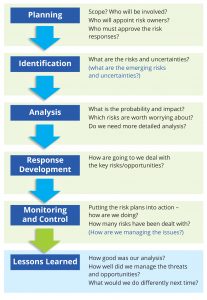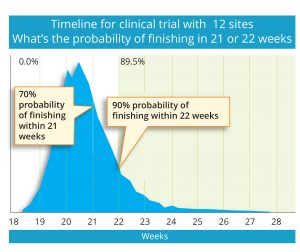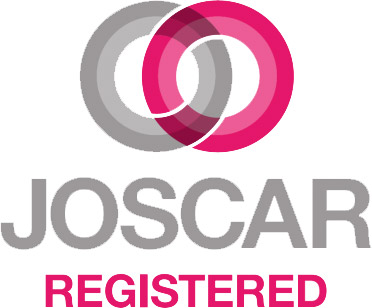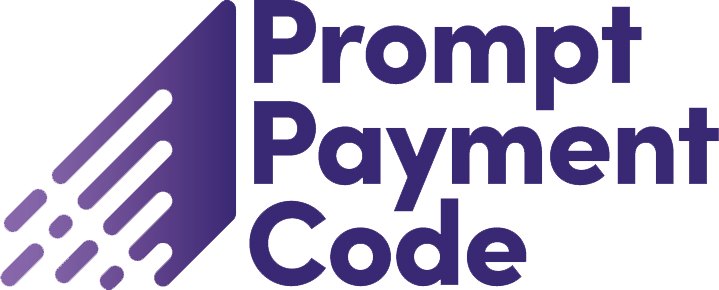In an increasingly competitive and cost-sensitive environment, CROs need to be better informed on how risky a particular bid price might be (the probability of making a profit or loss). As well as the confidence of achieving milestones. Or risk walking into bids blind.
Across the pharmaceutical industry the pressure to reduce the costs of drug development is intense. Many large companies are reducing their R&D budgets while small companies need to ensure that they extract the maximum value from their limited funding. Given that clinical trials make up a significant proportion of the total spend, they are coming under even greater scrutiny. For CROs this creates a challenging operating environment.
Beyond Phase 1, clinical trials become increasingly complex. For large studies, tens or even hundreds of investigators globally are sub-contracted to find and recruit the right patients, often in competition with other trials for the same patients. The interaction between the various elements in these complex situations creates a high degree of uncertainty, so that the outcomes in terms of timelines and cost are hard to predict. Even if the same trial was to be repeated, there is a low probability that the same timelines and budget could be achieved. Despite this complexity, sponsors often expect CROs to prepare a bid for a multi-million dollar trial based on a study synopsis in less than a week. In other industry sectors, such as aerospace or defence, several months might be allowed for bidding on projects of similar value.
With that compressed timeframe there is precious little time to plan and cost the trial effectively. Added to which, sponsors expect that the timeline will be ‘aggressive’ and the price very ‘competitive’. But unless a CRO understands the impact of potential risks and uncertainties (see Definitions), they won’t understand how risky a particular bid price might be (the probability of making a profit or loss). Nor will they understand the confidence of achieving milestones. In other words, they are walking into the bid and bid defence blind. In an increasingly competitive and cost-sensitive environment, CROs need to be better informed.
What is the solution?
The first step is for the bid team to have a coherent view of the impact of the study’s risks and

uncertainties on the trial deliverables. Only then can they assess the probability of achieving particular timeline targets or budget, and make informed decisions.
Uncertainties often have a bigger impact on the project deliverables than risks. The biggest risk in all studies is that the basic planning assumptions are wrong. In such circumstances, it is tempting to think that, if only the bid team applies more time and effort, the estimates would improve. But as the UK Treasury has found when predicting inflation, the inherent uncertainties in the system mean that this is completely ineffective.
In complex projects it is inadequate to take simple approaches that use point or average values for the key variables (for example, the number of patients screened per centre per month). Unless everything happens exactly to plan and all the assumptions are correct, these single point estimates will give a false impression of accuracy.
When under pressure in preparing a bid, running a Monte Carlo analysis against the schedule, with uncertainty alone, can indicate issues with the schedule. It will also highlight whether there is a reasonable level of probability of delivering on time or budget: even before applying any risks. This could indicate the need to take a rapid and early decision on whether to bid.
Learn the lessons of previous trials
In the compressed time available, the quickest route to developing a risk-based bid is to access information on the risks and uncertainties from similar previous trials. Then, discussion with operations should be undertaken, concerning:
- Which risks actually happened?
- What was their impact?
- How effective were the risk mitigation actions?
- Are there any trial specific risks?
Modern risk management tools can greatly assist in this process by providing an easily searchable database, and views across the portfolio that integrate key lessons to learn from previous projects, and other current projects in the portfolio.
Use risk and uncertainty analysis to make key bid decisions
Applying a Monte Carlo approach that integrates risks and uncertainties provides a clear view of their impact on the trial timelines and costs. This defines the extremes of the range, as well as the probability of a particular outcome. When setting budget targets this is an invaluable tool for a CRO to answer the critical question, ‘at this price, what is the probability of making a profit or loss?’

Example timeline for clinical trial
By quickly adjusting the model to see if they can achieve an optimal balance of cost and time, this approach empowers the CRO to assess alternative strategies before presenting the bid to the sponsor. Questions to consider might include:
- What would be the impact on time and cost of opening more centres in two new countries?
- By how much does this improve our probability of hitting the required timeline targets?
Ultimately, this approach allows the team to identify those studies to walk away from because the probability of making a loss is too high. Of course, a CRO can choose to bid aggressively on some studies that are strategically important. But by adopting the Monte Carlo approach consistently for all studies, the head of a therapeutic area can assess the risk exposure across their portfolio. Another benefit of this approach for a CRO is that it provides a sound basis for entering into performance-based contracts (see Figure 2, page 20).
For example, a clinical trial is scheduled to take 20 weeks, but taking uncertainty into account Figure 2 shows that it could take between 18 and 28 weeks. Ultimately, the decision comes down to whether to commit to 21 or 22 weeks (with 70 per cent and 90 per cent confidence respectively). The final choice will depend on what level of risk you are prepared to take, your capacity to manage the potential overrun if you bid aggressively, the chance you will lose the contract to a competitor if you opt for a safer deadline, and so on. Without the Monte Carlo analysis, a CRO cannot understand if the bonus side of the contract would be achievable, or if the penalty side leaves them over-exposed.
Look for opportunities
In many cases the entire focus of the risk management efforts appears to be on the negative side, but it is equally important to use the process to identify and develop plans to exploit the inevitable opportunities that uncertain circumstances produce. In these cases, the CRO should find ways to increase the probability of these occurring. Are there any cost savings that could be identified by working with the same investigator? Can the timelines be reduced by applying more effort at key points (and reduce the overall ‘marching army’ costs for a study that runs late)?
Making risk acceptable
The approach detailed above will provide the CRO with a much better appreciation of the study dynamics and the impact of both risks and uncertainties on time and cost. In most other industries these would be topics for open discussion with the client or sponsoring organisation. Sponsors would expect all bidders to fully understand their potential impact and to have robust plans to manage them. This form of open dialogue appears to be relatively rare in the pharmaceutical world – although in the various partnering arrangements you would expect it to be more commonplace.
Perhaps both CROs and sponsors need to be working toward a more mature approach where there is an appreciation that risk and uncertainty are both inevitable and critical to success. This would, for example, allow the most appropriate risk owner (the person or group responsible for managing a risk) to be identified and would encourage a more collaborative and less confrontational approach to be adopted.
The benefits
CROs can benefit from adopting a risk-based approach to bid preparation and defence. For example, they can:
- Decide to ‘no-bid’ in the case of high risk trials that without a change to the scope have a low probability of making a profit – with the result that Business Development can focus on winning good, profitable business
- Submit at a bid price that realistically reflects the increased uncertainty and risk involved
- Take a strategic decision to proceed with the bid while knowing the exposure risk, and where the CRO ensures that is has the contingency funds to support it
Conclusion
Understanding a project’s uncertainties and proactively managing the potential risks gives a more accurate picture of what is feasible within a specified time-frame. It adds honesty and confidence to the bid and delivery process for both sponsor and service provider. Adopting risk management enables business development to build robust proposals that avoid the dangers of overpromising and under-delivering. When bidding, risk analysis ensures that you make informed decisions on the price and time-frames, helps you select the bids to respond to, and increases the quality of the business you win. The lesson from other industries is that uncertainty analysis and a risk-based approach to bidding is important and necessary.
First published in International Clinical Trials, February 2012











